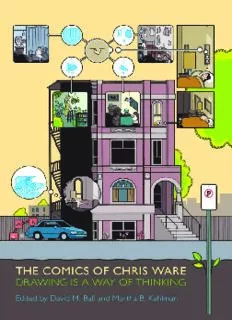
The Comics of Chris Ware: Drawing Is a Way of Thinking PDF
Preview The Comics of Chris Ware: Drawing Is a Way of Thinking
The Comics of Chris Ware The Comics of Chris Ware Drawing Is a Way of T hinking Edited by David M. Ball and Martha B. Kuhlman University Press of Mississippi Jackson Publication of this volume was made possible in part through grants provided by Dickinson College and Bryant University. The editors would also like to thank Meredith Milnes, Ellie Cutler, Shannon Kobran, and Tristan Deveney for their help and hard work and special thanks to Alec Thibodeau, for keeping us covered. All images and artwork, unless otherwise noted, are copyright © 2009 Chris Ware. The editors of this collection would like to thank Chris Ware for generous permission to reproduce his comics throughout this volume. Frontis: Portrait of Chris Ware by Ivan Brunetti. © 2010 Ivan Brunetti. www.upress.state.ms.us The University Press of Mississippi is a member of the Association of American University Presses. Copyright © 2010 by University Press of Mississippi All rights reserved Manufactured in the United States of America First printing 2010 Library of Congress Cataloging-in-Publication Data The comics of Chris Ware : drawing is a way of thinking / edited by David M. Ball and Martha B. Kuhl- man. p. cm. Includes bibliographical references and index. ISBN 978-1-60473-442-3 (alk. paper) — ISBN 978-1-60473-443-0 (pbk. : alk. paper) 1. Ware, Chris, 1967–—Criticism and interpretation. I. Ball, David M., 1976– II. Kuhlman, Martha B. PN6727.W285Z63 2010 741.5’973—dc22 2009033755 British Library Cataloging-in-Publication Data available For Cara For Nicholas This page intentionally left blank Contents Introduction: Chris Ware and the “Cult of Difficulty” Martha B. Kuhlman and David M. Ball ix Contexts and Canons Inventing Cartooning Ancestors: Ware and the Comics Canon Jeet Heer 3 Masked Fathers: Jimmy Corrigan and the Superheroic Legacy Jacob Brogan 14 The Limits of Realism: Alternative Comics and Middlebrow Aesthetics in the Anthologies of Chris Ware Marc Singer 28 Chris Ware’s Failures David M. Ball 45 Artistic Intersections Chris Ware and the Burden of Art History Katherine Roeder 65 In the Comics Workshop: Chris Ware and the Oubapo Martha B. Kuhlman 78 Comics and the Grammar of Diagrams Isaac Cates 90 The Urban Landscape On Modernism’s Ruins: The Architecture of “Building Stories” and Lost Buildings Daniel Worden 107 Chris Ware’s “Building Stories,” Gentrification, and the Lives of/in Houses Matt Godbey 121 vII Reading History Confronting the Intersections of Race, Immigration, and Representation in Chris Ware’s Comics Joanna Davis-McElligatt 135 Public and Private Histories in Chris Ware’s Jimmy Corrigan Shawn Gilmore 146 Autobiography with Two Heads: Quimby the Mouse Benjamin Widiss 159 Everyday Temporalities Chris Ware and the Pursuit of Slowness Georgiana Banita 177 Imagining an Idiosyncratic Belonging: Representing Disability in Chris Ware’s “Building Stories” Margaret Fink Berman 191 Past Imperfect: “Building Stories” and the Art of Memory Peter R. Sattler 206 Appendix: A Guide to Chris Ware’s Primary Works 223 Selected Bibliography 225 Contributors 231 Index 235 vIII CoNTENTS Introduction: Chris Ware and the “Cult of Difficulty” Martha B. KuhlMan and david M. Ball Reading Chris Ware’s comics for the first time can be a disorienting experi- ence. Why does the hardcover edition of Jimmy Corrigan: The Smartest Kid on Earth have such an enigmatic and ornate dust jacket? Where exactly are the author’s name and the title of the work, and what is the purpose of the cover’s intricate diagrams and cutout instructions? The curious few who un- fold the cover are rewarded with a map that is comprised of panels of varying sizes and orientations with abrupt shifts in scale, offering a world-historic vision of multiple generations and transatlantic connections between Irish immigration and the Middle Passage (see plate 1). Arrayed on the page with a dizzying visual intensity, these tiny scenarios are punctuated cryptically by conjunctions and phrases such as “Thus,” “But,” “And So” and traversed by a network of arrows and lines (dashed or solid) that operates according to an initially inscrutable logic. If this seems too daunting, turning to the endpa- pers reveals “General Instructions,” followed by an “Introduction” and five sections that culminate in an exam, all rendered in painfully tiny type that requires preternatural vision or bringing the book so close to your face that it almost touches your nose. As the cover warns us, what we have here is definitely “a bold experiment in reader tolerance,” and many will not have the time, interest, or patience for it. Put simply, this volume is not for them. But for those readers who, fascinated and challenged by the worlds that Ware has constructed, seek to gain new points of entry into his comics, this collection offers a range of mul- tidisciplinary perspectives that we hope will inspire lively discussions and open previously unexplored avenues for research. This volume offers the first such sustained critical analysis of Chris Ware’s already prodigious body of work, yielding a varied, provocative collection of essays that spans multiple approaches and orientations—from literary theory to urban studies, disabil- ity studies to art history, critical race theory to comics history—in order to better understand and illuminate Ware’s graphic narratives. In his 2004 cover story for the New York Times Magazine, “Not Funnies,” Charles McGrath predicts that comics are the next new literary form and praises Jimmy Corrigan as “easily the most beautiful and most complicated of all the new graphic novels.”1 Writing one year later in the New Yorker, art critic Peter Schjeldahl identifies Ware as belonging to a “cult of difficulty” that has always characterized avant-gardes, from the cubist experiments of Pica- sso and Braque to the obscure erudition of Eliot and Pound.2 These compari- sons would undoubtedly embarrass Ware, but Schjeldahl and McGrath are Ix
Description: